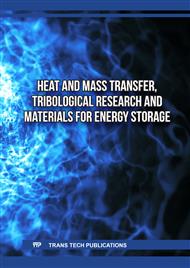p.103
p.113
p.133
p.151
p.157
p.165
p.171
p.177
p.185
Electrochemical Performance of Hydrothermal Synthesized Fe3O4/ReS2 Heterostructure for Supercapacitor Electrodes
Abstract:
Developing materials for electrodes with engineered interfaces is important for improving supercapacitor performance. Combining metal oxides and two-dimensional (2D) transition-metal dichalcogenides (TMDs) is a promising approach to develop enhanced supercapacitor electrodes. To the best of our knowledge, the electrochemical activity and energy storage of the Fe3O4/ReS2 heterostructure-based electrodes have not been reported in the literature. Therefore, this study employed a two-step hydrothermal method to synthesize a Fe3O4/ReS2 heterostructure and investigated its electrochemical performance. The developed material exhibited exceptional specific capacitance, capacity retention, and high energy and power densities. Moreover, various characterization techniques, including SEM, TEM combined with EDX, and XRD, were employed to examine the surface and structural properties of the produced heterostructures. Electrochemical measurements for supercapacitor application were conducted in 2 M KOH electrolytes for all the developed electrodes. The Fe3O4/ReS2 electrode displayed an excellent energy density of 49.31 Wh/Kg, a power density of 550 W/Kg, a specific capacitance of 322.7 F/g, at a current density of 1A/g, and attained 118 % capacitance retention after 2000 cycles at 10 A/g. A specific capacitance of 789.65 F/g was obtained at 5 mV/s. This work uncovers the potential of Fe3O4/ReS2 heterostructures as promising electrode materials for high-performance energy storage applications.
Info:
Periodical:
Pages:
157-163
Citation:
Online since:
October 2025
Authors:
Keywords:
Price:
Сopyright:
© 2025 Trans Tech Publications Ltd. All Rights Reserved
Share:
Citation:


